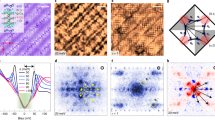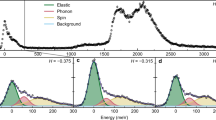Abstract
Understanding what controls the dynamics of the quasiparticle that results when a hole is doped into an antiferromagnetically ordered CuO2 layer is the first necessary step in the quest for a theory of the high-temperature superconductivity in cuprates. Here we show that the long-held belief that the quantum spin fluctuations of the antiferromagnetic background play a key role in determining this dynamics is wrong. Indeed, we demonstrate that the correct, experimentally observed quasiparticle dispersion is generically obtained for a three-band model describing the hole moving on the oxygen sublattice and coupled to a Néel lattice of spins without spin fluctuations. We argue that results from one-band model studies actually support this conclusion, and that this significant conceptual change in our understanding of this phenomenology opens the way to studying few-hole dynamics, to accurately gauge the strength of the ‘magnetic glue’ and its contribution to superconductivity.
This is a preview of subscription content, access via your institution
Access options
Subscribe to this journal
Receive 12 print issues and online access
$209.00 per year
only $17.42 per issue
Buy this article
- Purchase on Springer Link
- Instant access to full article PDF
Prices may be subject to local taxes which are calculated during checkout




Similar content being viewed by others
References
Bednorz, J. G. & Müller, K. A. Possible high T c superconductivity in the Ba–La–Cu–O system. Z. Phys. B 64, 189–193 (1986).
Emery, V. J. Theory of high-T c superconductivity in oxides. Phys. Rev. Lett. 58, 2794–2797 (1987).
Zaanen, J., Sawatzky, G. A. & Allen, J. W. Band gaps and electronic structure of transition-metal compounds. Phys. Rev. Lett. 55, 418–421 (1985).
Lee, P. A., Nagaosa, N. & Wen, X-G. Doping a Mott insulator: Physics of high-temperature superconductivity. Rev. Mod. Phys. 78, 17–85 (2006).
Ogata, M. & Fukuyama, H. The tJ model for the oxide high-T c superconductors. Rep. Prog. Phys. 71, 036501 (2008).
Zhang, F. C. & Rice, T. M. Effective Hamiltonian for the superconducting Cu oxides. Phys. Rev. B 37, 3759–3761 (1988).
Eskes, H. & Sawatzky, G. A. Tendency towards local spin compensation of holes in the high-Tc copper compounds. Phys. Rev. Lett. 61, 1415–1418 (1988).
Wells, B. O. et al. E versus k relations and many body effects in the model insulating copper oxide Sr2CuO2Cl2 . Phys. Rev. Lett. 74, 964–967 (1995).
Andersen, O. K., Liechtenstein, A. I., Jepsen, O. & Paulsen, F. LDA energy bands, low-energy Hamiltonians, t′, t′′, t⊥(k) and J⊥ . J. Phys. Chem. Solids 56, 1573–1591 (1995).
Leung, P. W., Wells, B. O. & Gooding, R. J. Comparison of 32-site exact-diagonalization results and ARPES spectral functions for the antiferromagnetic insulator Sr2CuO2Cl2 . Phys. Rev. B 56, 6320–6326 (1997).
Damascelli, A., Hussain, Z. & Shen, Z-X. Angle-resolved photoemission studies of the cuprate superconductors. Rev. Mod. Phys. 75, 473–541 (2003).
Ronning, F. et al. Universality of the electronic structure from a half-filled CuO2 plane. Phys. Rev. B 67, 035113 (2003).
Pavarini, E., Dasgupta, I., Saha-Dasgupta, T., Jepsen, O. & Andersen, O. K. Band-structure trend in hole-doped cuprates and correlation with Tc, max . Phys. Rev. Lett. 87, 047003 (2001).
Lau, B., Berciu, M. & Sawatzky, G. A. High-spin polaron in lightly doped CuO2 planes. Phys. Rev. Lett. 106, 036401 (2011).
Möller, M., Sawatzky, G. A. & Berciu, M. Magnon-mediated interactions between fermions depend strongly on the lattice structure. Phys. Rev. Lett. 108, 216403 (2012).
Lau, B., Berciu, M. & Sawatzky, G. A. Computational approach to a doped antiferromagnet: Correlations between two spin polarons in the lightly doped CuO2 plane. Phys. Rev. B 84, 165102 (2011).
Berciu, M. Few-particle Green’s functions for strongly correlated systems on infinite lattices. Phys. Rev. Lett. 107, 246403 (2011).
Hirsch, J. E. Effect of orbital relaxation on the band structure of cuprate superconductors and implications for the superconductivity mechanism. Preprint at http://arXiv.org./abs/1407.0042 (2014).
Zaanen, J. & Oles, A. M. Canonical perturbation theory and the two-band model for high-Tc superconductors. Phys. Rev. B 37, 9423–9438 (1988).
Ding, H-Q., Lang, G. H. & Goddard III, W. A. Band structure, magnetic fluctuations, and quasiparticle nature of the two-dimensional three-band Hubbard model. Phys. Rev. B 46, 14317–14320 (1992).
Trugman, S. A. Interaction of holes in a Hubbard antiferromagnet and high-temperature superconductivity. Phys. Rev. B 37, 1597–1603 (1988).
Berciu, M. & Fehske, H. Aharonov-Bohm interference for a hole in a two-dimensional Ising antiferromagnet in a transverse magnetic field. Phys. Rev. B 84, 165104 (2011).
Emery, V. J. & Reiter, G. Mechanism for high-temperature superconductivity. Phys. Rev. B 38, 4547–4556 (1988).
Frenkel, D. M., Gooding, R. J., Shraiman, B. I. & Siggia, E. D. Ground-state properties of a single oxygen hole in a CuO2 plane. Phys. Rev. B 41, 350–370 (1990).
Petrov, Y. & Egami, T. Exact-diagonalization study of electron-lattice coupling in the effective two-band tJ model. Phys. Rev. B 58, 9485–9491 (1998).
Sushkov, O. P., Sawatzky, G. A., Eder, R. & Eskes, H. Hole photoproduction in insulating copper oxide. Phys. Rev. B 56, 11769–11776 (1997).
Harrison, W. A. Elementary Electronic Structure (World Scientific, 1999).
Haverkort, M. W., Elfimov, I. S. & Sawatzky, G. A. Electronic structure and self energies of randomly substituted solids using density functional theory and model calculations. Preprint at http://arXiv.org./abs/1109.4036 (2011).
Acknowledgements
We thank B. Lau and W. Metzner for insightful comments. This work was funded by NSERC, QMI and CIfAR.
Author information
Authors and Affiliations
Contributions
H.E. and M.B. performed the numerical calculations. All authors contributed to the data analysis and the writing of the manuscript.
Corresponding author
Ethics declarations
Competing interests
The authors declare no competing financial interests.
Rights and permissions
About this article
Cite this article
Ebrahimnejad, H., Sawatzky, G. & Berciu, M. The dynamics of a doped hole in a cuprate is not controlled by spin fluctuations. Nature Phys 10, 951–955 (2014). https://doi.org/10.1038/nphys3130
Received:
Accepted:
Published:
Issue Date:
DOI: https://doi.org/10.1038/nphys3130
This article is cited by
-
Anomalous Ferromagnetism of quasiparticle doped holes in cuprate heterostructures revealed using resonant soft X-ray magnetic scattering
Nature Communications (2022)
-
Orbital structure of the effective pairing interaction in the high-temperature superconducting cuprates
npj Quantum Materials (2021)
-
Features of the Generalized Dynamics of Quasiparticles in Graphene
Nanoscale Research Letters (2017)
-
Correlation induced electron-hole asymmetry in quasi- two-dimensional iridates
Nature Communications (2017)



